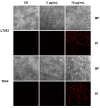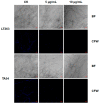Evaluation of Inhibitory Effect and Mechanism of Euphorbia Factor L3 against Phytophthora capsici
- PMID: 37049722
- PMCID: PMC10096396
- DOI: 10.3390/molecules28072958
Evaluation of Inhibitory Effect and Mechanism of Euphorbia Factor L3 against Phytophthora capsici
Abstract
Phytophthora capsici is a highly destructive phytopathogenic oomycete with a broad host range and is responsible for tremendous losses. Euphorbia factor L3 (EFL3) is a natural plant-derived compound that has been widely studied in medicine and cosmetic applications. In this study, the sensitivity of 105 P. capsici isolates to EFL3 was determined, and the biological activity and physiological effects of EFL3 against P. capsici were investigated. The median effective concentration (EC50) values for EFL3 inhibition mycelial growth and spore germination ranged from 0.66 to 8.94 μg/mL (mean, 2.96 ± 0.91 μg/mL) and 1.63 to 13.16 μg/mL (mean, 5.30 ± 1.64 μg/mL), respectively. EFL3 treatment resulted in cell wall and cell membrane damage of P. capsici, which was revealed by morphological and ultrastructural observations, propidium iodide (PI) and calcofluor white (CFW) staining, and measurements of relative conductivity as well as malondialdehyde (MDA) and glycerol contents. In addition, the contents of phospholipid and cellulose, which are the major components of cell membrane and cell wall, were significantly reduced following EFL3 treatment. Furthermore, EFL3 provided protective as well as curative efficacies against P. capsici on detached tomato leaves and pepper seedlings in vivo. These data show that EFL3 exhibits strong inhibitory activity against P. capsici, thereby suggesting that it could be an effective alternative for controlling P. capsici-induced diseases.
Keywords: Euphorbia factor L3; Phytophthora capsici; action mechanism; baseline sensitivity; botanical fungicide.
Conflict of interest statement
The authors declare no conflict of interest.
Figures









Similar articles
-
Antioomycete activity and mechanism of neoechinulin A from the marine fungus Aspergillus amstelodami 012393 against Phytophthora capsici: neoechinulin A against Phytophthora capsici.Pest Manag Sci. 2025 Aug 22. doi: 10.1002/ps.70149. Online ahead of print. Pest Manag Sci. 2025. PMID: 40843946
-
Antioomycete Activity and Mechanism of Territrem B, against Phytophthora capsici in Prevention of Phytophthora Blight.J Agric Food Chem. 2025 Aug 6;73(31):19386-19396. doi: 10.1021/acs.jafc.5c01446. Epub 2025 Jul 10. J Agric Food Chem. 2025. PMID: 40638848
-
Home treatment for mental health problems: a systematic review.Health Technol Assess. 2001;5(15):1-139. doi: 10.3310/hta5150. Health Technol Assess. 2001. PMID: 11532236
-
Transcriptional regulation of hormone signalling genes in black pepper in response to Phytophthora capsici.BMC Genomics. 2024 Sep 30;25(1):910. doi: 10.1186/s12864-024-10802-4. BMC Genomics. 2024. PMID: 39350031 Free PMC article.
-
Inhaled mannitol for cystic fibrosis.Cochrane Database Syst Rev. 2018 Feb 9;2(2):CD008649. doi: 10.1002/14651858.CD008649.pub3. Cochrane Database Syst Rev. 2018. Update in: Cochrane Database Syst Rev. 2020 May 1;5:CD008649. doi: 10.1002/14651858.CD008649.pub4. PMID: 29424930 Free PMC article. Updated.
Cited by
-
The Antimicrobial Extract Derived from Pseudomonas sp. HP-1 for Inhibition of Aspergillus flavus Growth and Prolongation of Maize Seed Storage.Foods. 2025 May 16;14(10):1774. doi: 10.3390/foods14101774. Foods. 2025. PMID: 40428553 Free PMC article.
-
The Effects of Antofine on the Morphological and Physiological Characteristics of Phytophthora capsici.Molecules. 2024 Apr 25;29(9):1965. doi: 10.3390/molecules29091965. Molecules. 2024. PMID: 38731455 Free PMC article.
References
MeSH terms
Grants and funding
- 32202390, 32270404, and 31970375/National Natural Science Foundation of China
- LYKJ[2021]18/Innovation and Promotion Project for Forestry Science and Technology of Jiangsu Province
- BE2022370/Key R&D Program of Jiangsu Province
- JSPKLB202201/Open Fund of Jiangsu Key Laboratory for the Research and Utilization of Plant Resources
LinkOut - more resources
Full Text Sources
Research Materials
Miscellaneous

